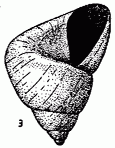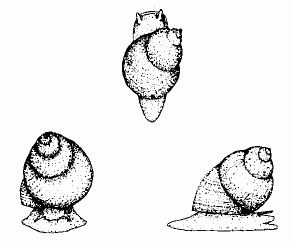
| Palaeos |  |
Paragastropoda |
| Mollusca | Paragastropoda |
| Page Back | Unit Up | Clade Up: Conchifera / Helcionelloida |
Page Next |
| Unit Back | Clade Down: Pelagiellida Mimospirida |
Mollusca References | Unit Next |
|
Abbreviated Dendrogram
CONCHIFERA `==Helcionelloida `--+--PARAGASTROPODA | |--Pelagiellida | `--Mimospirida | |--Onychochilidae | `--+--Cliospiridae | `-?Omphallocirridae `--+--Bellerophontoidea (torted) `--GASTROPODA (crown group) |
Contents
Overview |
Introduction
History of the Concept
Ecology and Possible Physiology
Diagnosis
Systematics
Taxa on This Page

illustration © xxxx from Knight et al 1960 Systematic descriptions [Archaeogastropoda]. In Moore, R. C. (ed.) Treatise on Invertebrate Paleontology p. I 187
The Paragastropoda are one of what must be a number of extinct molluscan clades that have been overlooked because of a superficial resemblance of their shells to gastropods, or (in other instances) lumped in the wastebasket taxon of "Monoplacophora". They were a group of mostly small non-torted proto-gastropod-like mollusks with asymmetrically (helically) coiled shells, that are restricted to the early and middle Palaeozoic. While never very numerous or diverse, they held their own with the gastropods for some hundred million years
 The class Paragastropoda was coined by Linsley
& Kier (1984) on the basis of functional analysis of the shells of hyperstrophic (inverted - i.e. the apex points "downwards") and other Paleozoic forms considered to be gastropods because of the spiral (helical) shell. To make sense of the unusual shell shape (and hence deduced soft-part physiology and water flow patterns) of these early gastropod groups Linsley and Kier 1984 concluded that they were untorted and hence cannot be considered gastropods. Because they do not seem to be "Monoplacophora" either (and in any case the term Monoplacophora is polyphyletic grade, rather than a true taxon) they
suggested a new class, the Paragastropoda.
The class Paragastropoda was coined by Linsley
& Kier (1984) on the basis of functional analysis of the shells of hyperstrophic (inverted - i.e. the apex points "downwards") and other Paleozoic forms considered to be gastropods because of the spiral (helical) shell. To make sense of the unusual shell shape (and hence deduced soft-part physiology and water flow patterns) of these early gastropod groups Linsley and Kier 1984 concluded that they were untorted and hence cannot be considered gastropods. Because they do not seem to be "Monoplacophora" either (and in any case the term Monoplacophora is polyphyletic grade, rather than a true taxon) they
suggested a new class, the Paragastropoda.
In their paper Linsley and Kier include a number of groups traditionally considered gastropods - the Onychochilidae, Macluritidae, Clisospiridae, Pelagiellidae, and possibly the Euomphaloidea and the Aldanellidae. Of those, only the Aldanellidae and Pelagiellidae had a traditionally dubious status as Gastropods
Subsequent work, as Wagner (2001: 1130) summarizes, has partially supported Linsley and Kier's work. Dzik (1982, 1994) has shown that the protoconchs of onychochilids are similar to those of pelagiellids, but unlike gastropod protoconchs. Outgroup analyses of various Cambrian mollusks by Wagner (1999) also linked onychochilids to pelagiellids, and suggested that both were only distantly related to true gastropods.
Thus the evidence for a pelagiellid-onychochilid clade is looking good. As for the other taxa cited by Linsley & Kier, the protoconchs of macluritids still are unknown, but euomphalids exhibit a variety of protoconch types, all of which are found in gastropods [Wagner 2001]. Flow-tank studies (Morris, 1991) indicate that the shell morphology of Maclurites would encourage Bernoulli effects and thus facilitate suspension feeding, but only if it was a torted mollusk [ibid]. Also, cladistic analysis (Wagner 1999) indicates a close relationship between the Macluritiodea and the Euomphaloidea. So if the Euomphalids are conventional (albeit very primitive and early) gastropods, the Macluritids are as well.
Following Yochelson 1978, the Aldanellidae are here considered non-molluscs and hence also removed from the Paragastropoda
It should be pointed out that even today there is not unanimity regarding the status of the Paragastropoda, and a number of workers in this field still consider them to be an artificial group, or perhaps included in the Gastropoda. Linsley and Kier 1984 themselves admit that the Paragastropoda as they define it represents a grade, rather than a clade, and is unlikely to be monophyletic.
Image: Onychochilius from Linsley & Kier (1984).
According to Linsley and Kier 1984, the less specialized Paragastropods like the Pelagiellidae and Onychochilidae were "mobile browsers", but later forms such as Cliospiridae and the Macluritidae (which, following Wagner 1999, it is suggested are actually gastropods), became sedentary, presumably filter feeders.
If the paragastropods are more basal than the gastropods, but more derived (belonging to the Gastropod-and-related-forms clade) than the Polyplacophora and Tryblidiida, it might not be unreasonable to assume that physiologically they would have characteristics shared by Polyplacophora, Tryblidiida, and the most primitive extant gastropods (the Docoglossa or Patelliforms), but lost in more specialized gastropods. Of course, they would probably have various specializations as well, although none were obviously sufficient to allow them to survive the Paleozoic. It can be suggested then that - as with chitons, Tryblidiida, and docoglossa gastropods, they had "docoglossa" radula, their sense organs were very rudimentary, they lacked antennae, only moved slowly, and were most probably (as with "archaeogastropods") confined to hard substrates, although sedentary types presumably would rest on sand or mud. However, the presence of a sinus in the Pelagiellidae indicates that these forms at least had a siphon, although it is not clear if mimospirid paragastropods had. Also, sedentary forms had some sort of way of catching suspended particles in the water currents, so we can tentatively assume a mucus net of some sort.
Class Paragastropoda Linsley & Kier, 1984
"Anisostropically coiled, untorted mollusks. Shells either hyperstrophic or orthostrophic. Members with elongate apertures with these elongated at approximately right angles to aperture at elongation of torted gastropods. The inhalant water current enters under the spire with the result that the "base" of the shell is frequently concave to accommodate the inhalant stream. Position of anus frequently marked by angulation or re-entrant at the outer part of upper whorl surface of aperture. Pretorsional left gill presumably lost."
Linsley and Kier 1984 p.249
The upper table shows the original classification of Linsley and Kier, the one beneath it the classification adopted here. Faint text means the taxa is only tentatively placed here
Class PARAGASTROPODA Linsley & Kier
Order Orthostrophina Linsley & Kier
Superfamily Pelagiellacea (= Pelagielloidea)
Family Pelagiellidae
Family ? Aldanellidae Linsley & Kier
Order Hyperstrophina Linsley & Kier
Superfamily Onychochilacea (= Onychochiloidea)
Family Onychochilidae
Family Cliospiridae
Subfamily Cliospirinae
Subfamily Trochoclisinae
Subfamily Atracurinae
Superfamily Macluritacea (= Macluritoidea)
Family Macluritidae
Superfamily ? Euomphalacea (= Euomphaloidea)
Family Euomphalidae
Family Omphalotrochidae
Family Omphalocirridae
Family Oriostomatidae
|
Class PARAGASTROPODA
Order Pelagiellida
Family Pelagiellidae
Order Mimospirida
Family Onychochilidae
Family Cliospiridae
Subfamily Cliospirinae
Subfamily Trochoclisinae
Subfamily Atracurinae
Family Yangtzespiriidae
Order Unspecified
? Family Omphalocirridae
|
| Page Back | Page Top | Unit Home | Page Next |
page uploaded 25 February 2003,
last modified ATW060227
checked ATW050720
original material by M. Alan Kazlev all other material © original authors or
sources